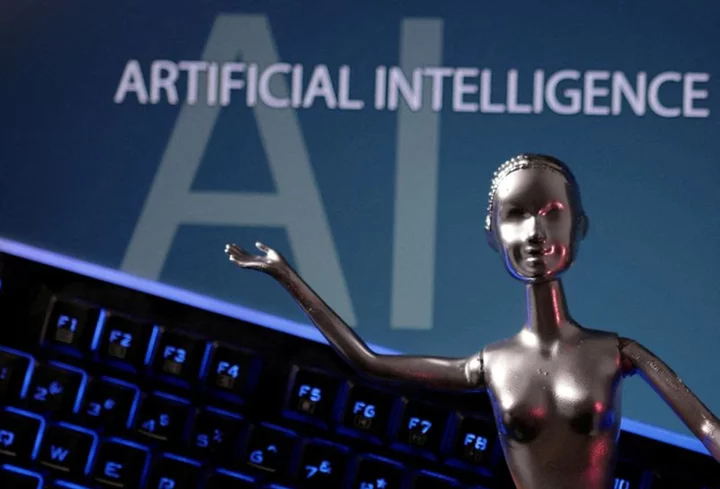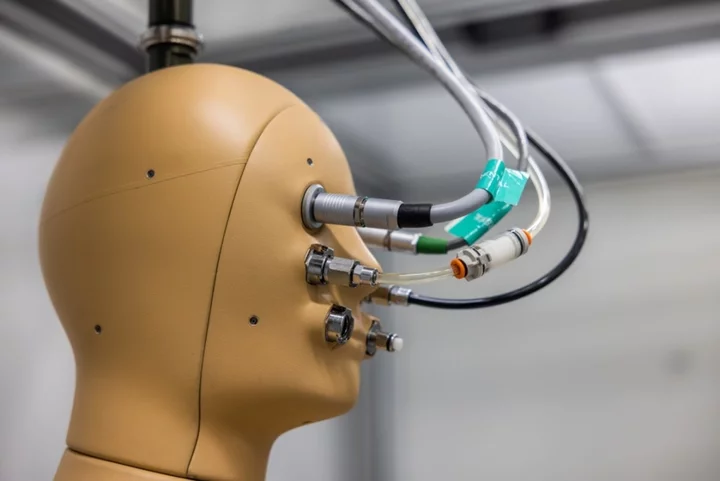
Macron Polishes France’s AI Agenda in Meeting With Meta, Google
French President Emmanuel Macron met with artificial intelligence experts from Meta Platforms Inc. and Alphabet Inc.’s Google, among
2023-06-10 00:22

Factbox-Jefferies sees AI fuelling next wave of innovation in oil and gas sector
With AI rapidly becoming a buzzword across industries, oil and gas companies are exploring ways to use this
2023-06-09 23:20

Taylor Swift, Drake May See Streaming Pay Rise Under New Plan
Universal Music Group NV, the world’s largest record company, is talking with the music service SoundCloud Ltd. about
2023-06-09 05:59

iOS 17: Apple reveals a host of extra updates to new iPhone operating system
Apple has revealed a host of new updates coming to the iPhone. The company launched iOS 17, its new iPhone operating system, this week. It was detailed at its annual Worldwide Developers Conference, which also saw the long-awaited unveiling of its Vision Pro headset. During that event, Apple showed off new features for the iPhone that included new messaging features and the option to twist the iPhone to the side and have it show a special “ambient” mode. But many features appear to have been left without discussion during that same introduction. Now Apple has published a new list of updates that were presumably left out of the update for reasons of time. They include a host of Apple Music features: the ability to make collaborative playlists, control music in the car, sing along to songs in a karaoke mode while seeing video of yourself, and more. Apple also announced offline downloads in Maps, for times when connections may be difficult, and Apple Fitness tools that let users generate a workout routine. Apple News, Podcasts, Apple Books and payments all get other updates. Apple has also added a new ID tool within wallet, that means users can show businesses proof of their age through their phone. That will let people quickly pay for alcohol purchases, for instance, or prove their identity for car rentals, Apple suggested. The full list of updates can be seen on Apple’s website. Unusually, Apple is allowing any users to get hold of the developer version of the new update for free, meaning that it is available right after the launch. But most users are still advised not to install it, given that it might come with potentially disastrous bugs. The public beta version of the software is expected in July. And Apple will fully launch iOS 17 in autumn, usually in September around the same time the new iPhone is launched. Read More ‘I saw the future. It left me in tears’ This could be the end of ‘ducking’ Apple lets people get brand new iPhone update early – but there’s a very big warning
2023-06-09 01:28

Major Google Bard update allows it to not just write code, but execute it
Google has unveiled a major new update to its AI chatbot Bard that significantly improves its powers of logic and reasoning. The latest version of the ChatGPT rival is now capable of both writing and executing code by itself, the tech giant announced, allowing it to figure out problems on a far deeper level than current generative AI systems. Google’s artificial intelligence tool is able to perform the new tasks through a new technique called “implicit code execution”, which enables Bard to detect computational prompts and run code in the background. The result is that Bard should theoretically be able to respond more accurately to mathematical tasks and coding questions, as it will have already tested the outcomes that it proposes. Until now, large language models (LLMs) like ChatGPT and Bard have been better suited to language and creative tasks, as they draw from their training data to predict what word will come next when talking about a specific subject. This allows them to produce text quickly but without deep thought, making them weaker when it comes to areas like reasoning and mathematics. “Our new method allows Bard to generate and execute code to boost its reasoning and maths abilities,” Google wrote in a blog post on Wednesday. “With the latest update, we’ve combined the capabilities of both LLMs and traditional code to improve accuracy in Bard’s responses. Through implicit code execution, Bard identifies prompts that might benefit from logical code, writes it ‘under the hood,’ executes it and uses the result to generate a more accurate response.” The new method improved Bard’s accuracy for coding and maths problems by roughly 30 per cent during internal tests, Google claimed. Accuracy remains one of the biggest issues with AI chatbots, with Google warning that despite the upgrade, Bard “won’t always get it right”. Unreliable or fabricated information generated by these AI tools is known as hallucinations, and they are typically delivered in a confident way that can be even more misleading for the user. ChatGPT creator OpenAI announced a potential new method to improve AI misinformation last month, involving two AI systems debating each other until they agree on the correct answer. Read More What is superintelligence? How AI could wipe out humanity – and why the boss of ChatGPT is doomsday prepping 10 ways AI will change the world – from curing cancer to wiping out humanity
2023-06-08 21:50

Scientists invent world's first ‘breathing, sweating, shivering’ robot
Scientists have created the world's first "breathing, sweating, shivering" robot in a major breakthrough. The technologically-advanced "thermal mannequin" known as ANDI has 35 controlled surfaces that allow the robot to produce sweat through 'pores'. Designed by US firm Thermetrics, there are just 10 ANDIs in the world. It was designed to gauge a better understanding of the health impacts of extreme temperatures on the body. "ANDI sweats, he generates heat, shivers, walks and breathes," explained Konrad Rykaczewski, principal investigator for the ASU research project. Rykaczewski continued: "There’s a lot of great work out there for extreme heat, but there’s also a lot missing. "We’re trying to develop a very good understanding of how heat impacts the human body so we can quantitatively design things to address it." Sign up for our free Indy100 weekly newsletter Some ANDIs are already being used by sports clothing companies to test garments. Meanwhile, ASU's version is the first that can be used outdoors. Jenni Vanos, associate professor in the School of Sustainability said: "You can’t put humans in dangerous extreme heat situations and test what would happen. "But there are situations we know of in the Valley where people are dying of heat and we still don't fully understand what happened. ANDI can help us figure that out." Later this year, ANDI will be paired with ASU's biometeorological heat robot to delve deeper into human sweating mechanisms. Ankit Joshi, an ASU research scientist leading the modelling and operating of ANDI, said: "We can move different BMI models, different age characteristics and different medical conditions (into ANDI),” "A diabetes patient has different thermal regulation from a healthy person. So we can account for all this modification with our customized models." Have your say in our news democracy. Click the upvote icon at the top of the page to help raise this article through the indy100 rankings.
2023-06-08 18:55

Biden administration to announce new steps to protect the LGBTQ community Thursday ahead of White House Pride celebration
President Joe Biden will announce a slew of actions Thursday aimed at protecting the LGBTQ+ community ahead of hosting what White House Domestic Policy Advisor Neera Tanden called "the largest Pride celebration in White House history."
2023-06-08 18:28

The brightest explosion ever seen in the universe has finally been explained
It’s the brightest explosion ever seen in the universe, but until now it’s been a mystery that couldn't be explained. Telescopes observed an enormous blast in October which was regarded as the biggest of all time. It was identified as a gamma-ray burst, named GRB 221009A, which came as a result of a massive star collapsing into a black hole. At the time it was a mystery as to why the explosion shone so brightly. Now, further research published in the journal Science Advances has uncovered the reason it was so bright is due to the fact it was facing directly at us and also pulled stellar material along with it. Sign up to our free Indy100 weekly newsletter Hendrik Van Earthen from the University of Bath said: “The slow fade of the afterglow is not characteristic of a narrow jet of gas, and knowing this made us suspect there was an additional reason for the intensity of the explosion, and our mathematical models have borne this out. “Our work clearly shows that the GRB had a unique structure, with observations gradually revealing a narrow jet embedded within a wider gas outflow where an isolated jet would normally be expected.” The research into GRB 221009A has the potential to further the study of huge gamma-ray bursts, which can produce as much energy as the Sun will in its entire lifetime in the space of just a few seconds. “GRB 221009A represents a massive step forward in our understanding of gamma-ray bursts, and demonstrates that the most extreme explosions do not obey the standard physics assumed for garden variety gamma-ray bursts,” Brendan O’Connor, GW graduate student and lead study author, said. “GRB 221009A might be the equivalent Rosetta stone of long GRBs, forcing us to revise our standard theories of how relativistic outflows are formed in collapsing massive stars.” Have your say in our news democracy. Click the upvote icon at the top of the page to help raise this article through the indy100 rankings.
2023-06-08 18:24

AirNow’s Interactive Map Shows You the Air Quality Index in Your Area
If you’re in the red on AirNow’s air quality map, you should stay inside.
2023-06-08 04:52

Scientists invent first ever ‘breathing, sweating, shivering’ robot
Scientists say they have built the first ever “breathing, sweating, shivering” robot, designed to cope and adapt to different temperatures. The heat-sensitive “thermal mannequin”, dubbed ANDI, features 35 individually controlled surfaces with pores that bead sweat like humans. Designed by US firm Thermetrics for use by researchers at Arizona State University, the robot was created to help better understand the health impacts of extreme temperatures on the human body. “ANDI sweats, he generates heat, shivers, walks and breathes,” said Konrad Rykaczewski, principal investigator for the ASU research project, whose work aims to identify and measure the effects of extreme heat on humans. “There’s a lot of great work out there for extreme heat, but there’s also a lot missing. We’re trying to develop a very good understanding of how heat impacts the human body so we can quantitatively design things to address it.” Some of the 10 sweating robots built by the researchers are already being used by clothing companies for garment testing, however ASU’s android is the only one that can be used outdoors. This allows experiments in previously impossible extreme heat environments, as well as studies into the impact of solar radiation. ASU researchers plan to test ANDI in heat-vulnerable areas around Phoenix this summer in an effort to understand how different ages and body types are impacted by high temperatures. “We can move different BMI models, different age characteristics and different medical conditions [into ANDI],” said Ankit Joshi, an ASU research scientist leading the modelling work and the lead operator of ANDI. “A diabetes patient has different thermal regulation from a healthy person. So we can account for all this modification with our customised models.” The results will be used to design interventions, such as cooling clothes and technologies to protect against heat stroke and heat-related deaths. Read More Electric cars could save more than 100,000 lives, study claims Electric cars could save more than 100,000 lives, study claims ‘I saw the future. It left me in tears’ This could be the end of ‘ducking’
2023-06-08 01:46

Astronomers have discovered a ‘treasure trove’ hidden 17 million light-years away
Astronomers have discovered a ‘treasure trove’ after capturing an image of a barred spiral galaxy located 17 million light-years away. The findings were made after the James Webb Space Telescope (JWST) gave a more in depth look at galaxy NGC 5068. The feature is found in the constellation of Virgo, and it’s thought that the discovery could lead scientists to discover more about barred spiral galaxies like our own. The observations are all part of a series of findings from the JWST, with the telescope having collected images of 19 galaxies to add to our understanding of star-birthing galaxies. The bars can be seen in the upper left-hand section of the image posted by NASA below and they’re made up of tightly clustered stars. Sign up to our free Indy100 weekly newsletter It’s thought that structures like these take as long as two billion years to form, which could mean they’re a lot older than other galaxies. “This image of the central, bright star-forming regions of the galaxy is part of a campaign to create an astronomical treasure trove, a repository of observations of star formation in nearby galaxies,” Webb astronomers said, via sci.news. “These observations are particularly valuable to us for two reasons. The first is because star formation underpins so many fields in astronomy, from the physics of the tenuous plasma that lies between stars to the evolution of entire galaxies.” “By observing the formation of stars in nearby galaxies, we hope to kick-start major scientific advances with some of the first available data from Webb.” It continued: “The second reason is that Webb’s observations build on other studies using telescopes including the NASA/ESA Hubble Space Telescope and ground-based observatories.” They went on to say: “With its ability to peer through the gas and dust enshrouding newborn stars, Webb is particularly well-suited to explore the processes governing star formation. “Stars and planetary systems are born amongst swirling clouds of gas and dust that are opaque to visible-light observatories like Hubble or VLT.” Have your say in our news democracy. Click the upvote icon at the top of the page to help raise this article through the indy100 rankings.
2023-06-07 23:28

Your Ducking iPhone Will Soon Stop Autocorrecting the F-Word to ‘Duck’
A new iPhone update will spell the end for everyone’s least favorite autocorrect fail.
2023-06-07 21:57
